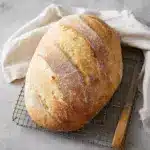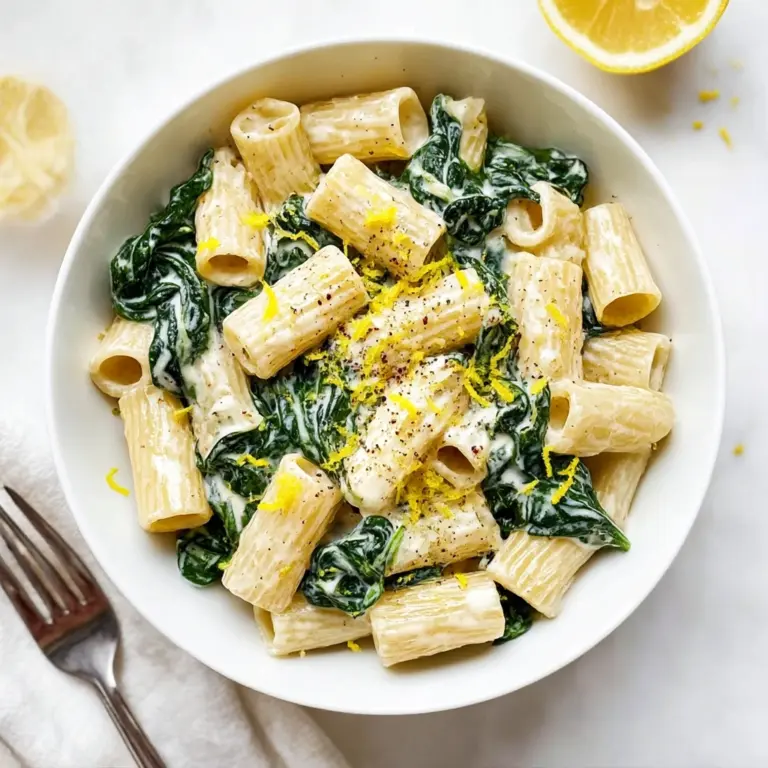Italian Bread Recipe
If you’ve ever longed for the comforting aroma and golden crackle of homemade Italian Bread wafting through your kitchen, you’re in the right place! This recipe captures the heart and soul of classic Italian baking with a surprisingly simple process and ingredients you likely already have in your pantry. Crispy on the outside, pillowy-soft on the inside, and gently scented with olive oil, this Italian Bread is the kind of loaf you’ll want to serve with every meal, share with friends, and make again and again.
Ingredients You’ll Need

Ingredients You’ll Need
The beauty of Italian Bread lies in its simplicity: just a handful of top-notch ingredients work together to create big, crave-worthy flavor and the kind of texture you expect from bakery-fresh bread. Each part matters, adding depth, chew, and that irresistible golden crust.
- Active Dry Yeast: Responsible for the lovely rise and open crumb; make sure it’s fresh for the best texture.
- Granulated Sugar: Gives yeast a boost and a subtle whisper of sweetness that enhances the bread’s flavor.
- Warm Water: Activates the yeast and binds the ingredients—be sure it’s warm, not hot, to keep those little yeasties happy.
- Bread Flour (or All-Purpose Flour): Bread flour brings chew and structure, but all-purpose works for a slightly softer crumb.
- Olive Oil: A drizzle of good olive oil lends richness, flavor, and helps the crust develop its signature golden hue.
- Salt: Essential for balancing flavors and bringing out all the nuanced notes in each bite.
How to Make Italian Bread
Step 1: Activate the Yeast
Start by stirring together your active dry yeast, granulated sugar, and warm water in a large bowl or the bowl of your stand mixer. That gentle warmth coaxes the yeast to life. Wait 5 to 10 minutes, or until you see a rich, foamy layer at the top—when you see that, you know you’re about to make bread magic happen.
Step 2: Mix the Dough
Now it’s time to layer in the flavor! Add 2 cups of bread flour, the olive oil, and salt. Stir everything together with a wooden spoon or your mixer’s dough hook until a shaggy dough forms. This is where your kitchen starts smelling like a bakery.
Step 3: Knead Until Smooth
Turn the rough dough onto a lightly floured surface. Knead by hand for about 10 minutes, working in just enough of the remaining flour until your dough is soft, smooth, and elastic. If you’re using a stand mixer, just let it go for about 5 minutes on medium speed. The dough will spring back when you press it—a sign it’s ready for the first rise.
Step 4: Let the Dough Rise
Shape the dough into a tight ball and pop it into a lightly oiled bowl, turning it once to coat. Cover with plastic wrap and let it rest in a cozy corner of your kitchen for about an hour, or until it doubles in size. Watching dough rise is always a bit like magic, isn’t it?
Step 5: Shape and Second Rise
After the first rise, gently punch down the dough and shape it into a classic Italian Bread batard—roughly a torpedo shape about 12 inches long. Place the dough onto a parchment-lined or lightly greased baking sheet. Cover with a tea towel and let it puff up for 20 to 30 minutes. This last rest gives you that bakery-style volume and a soft, airy crumb.
Step 6: Score and Bake
Use a bread lame, sharp razor, or serrated knife to slash a few shallow slits across the top of your loaf. This helps the bread expand beautifully in the oven. Bake at 400°F for 20 to 25 minutes until your kitchen smells dreamy and the loaf is burnished golden brown. Cool completely on a rack before slicing—if you can resist!
How to Serve Italian Bread
Garnishes
Italian Bread shines just as it is, but a little flourish goes a long way. Brush the warm loaf with a touch of melted butter or olive oil and a sprinkle of flaky sea salt, or try dusting with a whisper of grated Parmesan and minced fresh herbs for a beautiful finish.
Side Dishes
This bread has a way of cozying up to just about anything—think steaming bowls of pasta, hearty stew, or freshly made salads. Serve thick slices alongside tomato basil soup, or toast wedges to mop up every last drop of your favorite Italian sauce.
Creative Ways to Present
Why not slice your Italian Bread on the bias and turn it into crostini for bruschetta? Or cube it and make hearty croutons for a Caesar salad? For a show-stopper, create a DIY deli sandwich board with sliced meats, cheeses, and pickled veggies to let guests build their own perfect bites.
Make Ahead and Storage
Storing Leftovers
Italian Bread is best the day it’s made, but leftovers can be a treat too. Wrap the cooled loaf tightly in plastic wrap or foil, and store at room temperature for up to 2 days. A quick refresh in the oven can bring back some of that original magic.
Freezing
For longer storage, Italian Bread freezes like a dream. Simply wrap the loaf (or sliced portions) snugly in plastic wrap and then in foil. Freeze for up to 2 months. Thaw at room temperature, still wrapped, to avoid drying out.
Reheating
To bring back the just-baked texture, warm Italian Bread in a 350°F oven for 5 to 10 minutes. If it’s sliced, wrap in foil so it doesn’t get too crisp. This little trick revives the crust and makes the crumb soft and steamy, just like fresh out of the oven.
FAQs
Why didn’t my Italian Bread rise as much as expected?
There are a few culprits: old yeast, water that’s too hot or too cold, or a chilly kitchen could all slow down the rise. Make sure your yeast is fresh and proofed, your water is comfortably warm (about 110°F), and if your room is cold, let the dough rise somewhere warmer, like inside an unheated (but closed) oven.
Can I use all-purpose flour instead of bread flour?
Absolutely! All-purpose flour gives you a slightly softer crumb, while bread flour brings more chew, but either will give you delicious Italian Bread. Use what you have, and don’t worry—the loaf will still turn out wonderful.
Is it possible to make this Italian Bread recipe ahead for a dinner party?
Definitely. You can bake the loaf in the morning and rewarm it just before dinner for that fresh-from-the-oven feeling. Or, you can mix and knead the dough a day ahead, let it rise slowly in the fridge overnight, then shape and bake the next day.
How do I get that beautiful golden, crackly crust?
For the signature crust, bake your loaf on a preheated stone or sprinkle a little water into the oven when you put the bread in to bake—the steam helps create that crackle. And don’t forget to let the bread cool completely before slicing for the best texture!
Can I add herbs or cheese to the Italian Bread?
Yes! This recipe is a fantastic base for experimenting. Add a couple of teaspoons of finely chopped rosemary, thyme, or basil, or sprinkle in grated Parmesan for an herby, cheesy loaf.
Final Thoughts
Making homemade Italian Bread is one of those little joys that instantly makes your kitchen feel warm and inviting; I truly hope this recipe inspires you to give it a try. Share it with people you love, experiment with your own variations, and you’ll soon have your very own signature loaf!
Print
Italian Bread Recipe
- Total Time: 2 hours
- Yield: 1 loaf 1x
- Diet: Vegetarian
Description
This homemade Italian bread recipe yields a crusty, flavorful loaf with a soft interior. Perfect for sandwiches, dipping in olive oil, or enjoying on its own.
Ingredients
Dough:
- 2 ¼ teaspoons active dry yeast (1 packet)
- 1 teaspoon granulated sugar
- 1 cup warm water
- 2 ½ cups bread flour (or all-purpose flour)
- 2 tablespoons olive oil
- 1 teaspoon salt
Instructions
- Mix Yeast Mixture: In a large bowl or stand mixer, combine yeast, sugar, and warm water. Let stand until foamy.
- Add Ingredients: Mix in flour, olive oil, and salt until a dough forms.
- Knead Dough: Knead by hand or with a mixer until smooth and elastic.
- Rise: Let the dough rise until doubled in size.
- Shape and Bake: Shape the dough, let it rise again, then bake until golden brown.
Notes
- You can sprinkle sesame seeds or herbs on top before baking for added flavor.
- For a chewier crust, place a pan of water in the oven while baking.
- Prep Time: 20 minutes
- Cook Time: 25 minutes
- Category: Bread
- Method: Baking
- Cuisine: Italian
Nutrition
- Serving Size: 1 slice
- Calories: 150
- Sugar: 1g
- Sodium: 200mg
- Fat: 3g
- Saturated Fat: 0.5g
- Unsaturated Fat: 2g
- Trans Fat: 0g
- Carbohydrates: 27g
- Fiber: 1g
- Protein: 4g
- Cholesterol: 0mg
Keywords: Italian bread, homemade bread, crusty loaf, bread recipe







